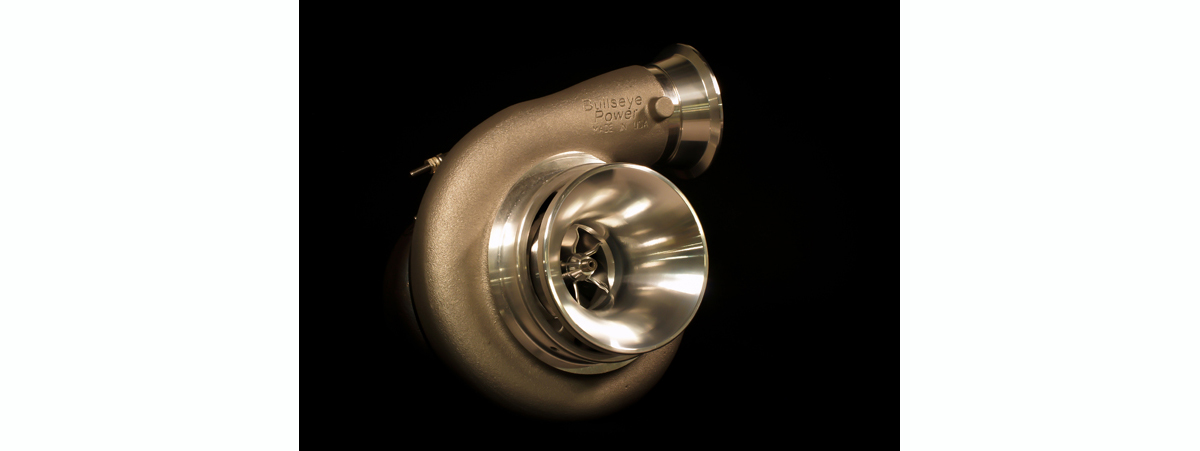By Stephen Kim Every race season brings a new wave of turbocharger innovations that offer incremental to moderate improvements in performance. Add them all up, however, and the cumulative progress achieved over the last 10 years is staggering to say the least. Ceramic ball bearings, billet compressor wheels, and stainless steel exhaust housings are just a few of the advancements that allow single-turbo 275 radial cars to run just as fast as twin-turbo Outlaw 10.5 cars from a decade or so ago. Even a seemingly insignificant part, like the nut holding the compressor wheel to the shaft, is painstakingly profiled to improve airflow. Now Bullseye Power has a new trick up its sleeves: adjustable compressor inlet bells that allow tuning the airflow characteristics of the turbo to match the airflow requirements of an engine. Bullseye's first-generation cover (bottom right) utilized a 5.5-inch inlet diameter and a 0.66 A/R ratio. The second-generation cover (bottom-left) featured a grooved inlet cover that increased airflow 3-5 percent. The third-gen cover (top right) utilized a 0.69:1 A/R ratio, and the company was able to design a new grooveless cover without sacrificing any airflow. The new fourth-generation cover is an evolution of the three prior designs. Manufacturers have continually revised the shape and overall design of the compressor inlet bell over the years, but Bullseye's new design allows racers to adjust it at the track by simply loosening a few set screws, and rotating the bell inward or outward on the threaded compressor housing by hand. The obvious question is, what's the point Turbos have recirculation grooves located directly in front of the compressor wheel inlet. These MWE (map width enhancement) grooves were originally designed to prevent surge, Bill Devine of Bullseye explained. Depending on the operating speed of the turbo and the specs of the engine it's attached to, the width of the groove can affect performance. Widening or narrowing the recirculation groove allows matching the volumetric efficiency of the turbo with the volumetric efficiency of the engine. Some motors will run better if you open up the groove, and other motors will respond better if you narrow it down. It all depends on a variety of factors such as cubic inches, cranking compression, camshaft design, and how well a turbo is sized for a particular combination. After loosening up three set screws, rotating the inlet bell one full turn changes its height 1/16 inch. Eight turns adjusts the bell inch, which is the most Bullseye recommends. Since the cover and inlet bell are made from the same grade of metal, seizing due to heat expansion isn't a concern. In essence, Bullseye's adjustable inlet bells are fine-tuning tools intended to maximize the performance potential of an engine. In classes that limit the size of the compressor, you can have a 302-, 351-, and 408ci engine all running the exact same turbo. Each engine has different airflow requirements, so an adjustable inlet bell allows changing the turbo's airflow characteristics accordingly, said Devine. Screwing the inlet bell inward and outward adjusts the width of the recirculation groove (silver) located directly in front of the compressor wheel. Some engines will prefer a wider groove, while others will make more power with a narrower groove. Think of it as a fine-tuning tool, just like adjusting the valve lash or plug gap. If you have more power than you can put to the ground, you might not see any difference at all. However, if you're racing in a class where everyone is running within 20-30 horsepower of each other, you can see a huge difference. Likewise, if you've maxed out your turbo and don't have the option of going to a bigger one, but you're still a tenth slower than the competition, then adjusting the width of the groove can make a big difference. The same applies if the compressor isn't sized optimally to the engine. Another cool feature of the fourth-gen cover is its removable V-band flange. According to Bullseye, many customers run a hose at the compressor outlet initially, but later upgrade a V-band flange. This requires welding a flange to the cover, or sending the entire turbo back to Bullseye so they can check all the clearances after modifying the cover. With the new fourth-gen cover, racers can upgrade to a V-band flange by simply screwing it on. Bullseye's tunable fourth-generation covers will be offered on the company's 66-, 72-, 75-, 76-, 80-, and 83mm turbos with larger sizes to follow. Both high-rise and low-rise bell designs will be available as well.
Posted By: Art Yang
Dec 18,
2015



